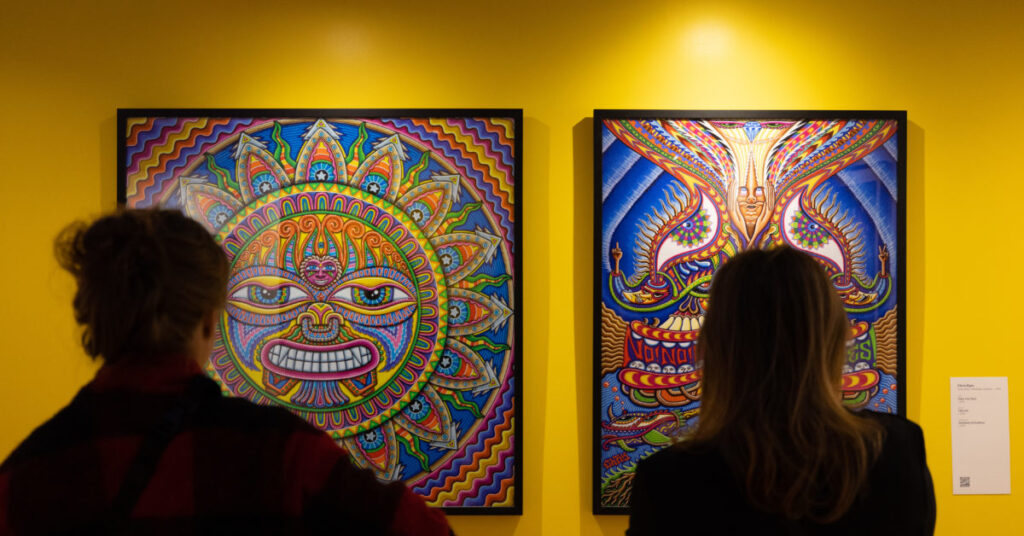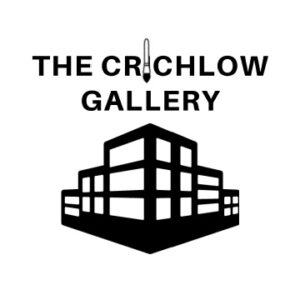
Whether you’re a fan of the mind-altering effects of hallucinogenic substances or not, it’s hard to deny their massive influence on society. At least that’s what Toronto’s newest immersive art exhibition is proposing. Psychedelics: The Experiential Exhibition—on until the new year—explores the many links between psychedelics and music, Indigenous cultures and storytelling. The exhibition has transformed the Lithuanian House, where it takes place, into a two-storey art gallery. Executive producer and curator James Drayton hopes the project will help destigmatize the use of psychedelics. “These substances are now being used—responsibly, in safe settings, with therapists and in controlled amounts—to help people with mental health conditions like PTSD, anxiety, depression and addiction,” Drayton explains. “There’s a changing story to tell about psychedelics, and that’s a big part of our mission with the exhibition.”
The first floor of the venue operates much like a traditional gallery, and the second floor offers an open-concept exploration of larger-scale pieces. Visitors start their trip by walking through four substance-themed rooms: peyote and mescaline, mushrooms (psilocybin), LSD and ayahuasca. They learn about each substance, including what it does to your body and brain plus its cultural relevance. The text is by Toronto-based writers John Semley and Kelly Pullen.
Here’s a guided tour of the exhibition.
A peyote journey
Bright purple and green lights cast incandescent hues through the peyote room, an exhibit put together by a couple who go by Clandestinos Art, individually known as artists Bruno Smoky and Shalak Attack. The duo, who have South American roots, wanted visitors to experience a sense of authenticity with regards to how peyote is used and embedded within their culture. “When I was telling them about the project, this was the topic they felt most connected to,” Drayton says. “It brings a layer of authenticity when you’re working with artists who are connected to the culture that these substances are native to.”
The gigantic mushrooms
The exhibition doesn’t provide any substances, but it does simulate their effects. The mushrooms room, for example, is filled with bouquets of big shiny silver mushrooms. And, with its floor-length mirrors, it’s one of the most selfie-friendly places. Casey Watson, the Toronto artist who put this space together, emphasized fun and whimsy.
Lucy in the sky with diamonds
In the LSD room, the relationship between the substance and music is the main focus. Twelve psychedelic-inspired albums hang on the walls, including The Beatles’ Yellow Submarine, Cream’s Disreali Gears, and The Jimi Hendrix Experience’s Axis: Bold as Love. Visitors also learn about the Stoned Ape theory—the idea, proposed by late ethnobotanist Terence McKenna, that psilocybin use helped our species evolve from Homo erectus to Homo sapiens.
Ayahuasca light show
The pièce de résistance is a massive unnamed seven-metre geometric sculpture that comes to life with indecipherable baritone sounds, laser beams and waves of colourful patterns. The nine-minute audiovisual experience, created by California artist GMUNK, is meant to simulate the effects of an ayahuasca trip. The top of the sculpture is suspended from the ceiling, and it is powered by three projectors. It took six months to put together. “The journey is euphoric and psychoactive. It is instinctual and it is native, spinning light and colour,” GMUNK explains.
A raccoon-filled staircase
Award-winning artist Emily May Rose, who became known in 2015 for her cartoonish Toronto raccoon murals, spent three days spray-painting the winding stairwell that connects the first-floor art gallery to the second-floor installations. “The first scene is one of classic city raccoons. But, as you go up the stairs, you realize that they’ve found mushrooms and are going through a magical forest with talking flowers,” May Rose says of her aptly named mural Higher and Higher. By the time visitors reach the top floor, it’s a full-on psychedelic experience.
The acid test room
You may think there’s a glaring typo as you enter the acid test room: a sign above the door reads ENTERANC. And, in an homage to Ken Kesey—whose “acid tests,” a series of parties in the 1960s that celebrated and cultivated the use of LSD, inspired artists such as the Grateful Dead—another sign asks: Can you pass the acid test? Behind the stage is a mind-bending image of blue, green and yellow lights—the result of oils, dyes, water, mirrors and lights working in conjunction—meant to simulate the effects of the substance. This room’s big draw is a stage where a number of rotating live performances take place. One night, for instance, a band played a Grateful Dead–themed concert.
This content was originally published here.



